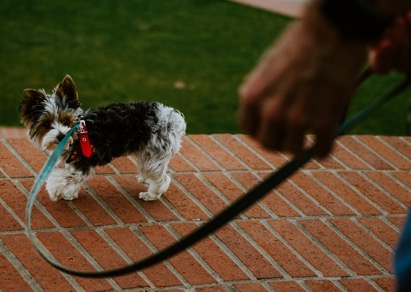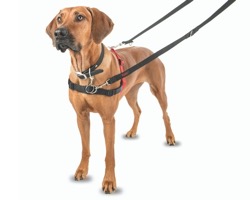How to stop a dog pulling on the lead
These notes will help you to train your dog or puppy to walk nicely to heel and not to pull on the lead.

But, whether you’re teaching a puppy or an older dog, the training process is much the same – it just takes longer to teach a dog who’s already learned that pulling on the lead is a fun thing to do – even if they seem to be choking themselves!
Tip 1:
Start off in a quiet place in the house and simply lure your dog or puppy to your leg and give them a treat. Take a step, give another treat. Take two steps and another treat (or click and treat). Take several steps and give a treat. Do this around the house and garden before using the lead. Then repeat the process with the lead on, but don't actually use it to pull your puppy or dog to you.
If they do try to pull on the lead, just stand still, holding the lead. Don’t play tug of war. Simply stand still. As soon as your dog stops pulling then say “good” and give them a treat. If that's taking more than a second or two, then guide them back to your leg and reward. (Note that halving the length of the lead can help you to be able to more easily reach your dogs mouth to lead them with your treat.)
Practise in several places around the house and garden. Next, when they at least understand the game a little, then go for a walk. Take good handful (i.e. perhaps half the meal!) of your dogs food (if you're not feeding complete dry food then use equivalent treats) with you. Walk slowly, practising both luring your dog to your leg and also standing still when they pull. Continue to reward them as above, each time they stop pulling or walk to heel. Gradually building up the number of steps you can take without them pulling on the lead.
Doesn’t it all sound so simple? Well, with lots of training practice and consistency, your dog should learn that pulling on the lead is not nearly as rewarding as being by your side. But, work slowly, gradually building up the training, and don’t expect miracles.
Here's some more crucially important advice.
If your dog is pulling already, then you have a difficult task. Working on training with your dog is best done little and often, so you can spend 4 * 5 minute sessions a day training your dog. BUT - what about the rest of the time? You still need to take your dog for nice long walks - and if dog pulling happens alot on your walk, then most of your training is going to waste. You're taking 1 step forwards with the training and 5 steps back on walks.
STOP bad habits!
Prevention is crucial to your success. That's where dog training aids help. Using Gentle Leader, Easy Walk Harness, a Halti or a Halti harness or Perfect Fit Harness helps to curb the pulling when you're on a walk and helps you to succeed with your training much more quickly.
Some people have said that they feel like they're giving in, or losing if they use a dog training aid. Please don't think like that. These training aids have been developed by experts to help to make training more successful and to help to take the stress out of your dog walks.
Technology is part of our lives now - where would we be without it? So why not use dog technology?
START good habits in your dog!
Useful Dog Training Aids to Stop Dogs Pulling
 Gentle Leader
Gentle Leader  Halti Harness
Halti Harness  Perfect Fit Harness
Perfect Fit HarnessPlease take care when introducing these to your dog and ensure that they are an appropriate product for your dog’s circumstances. Some dogs also need behaviour therapy to help them learn.
And finally – take things slowly! - If you can’t get your dog to stop pulling on the lead when you’re standing still then they will never learn to stop pulling when they’ve got some walking momentum.
Have fun with training : how to stop a dog pulling on the lead
Even more important dog training notes to help with your dog's pulling
- Always take care of safety when training and be prepared if you know your dog may pull – especially if the ground is muddy or slippy.
- Train little and often 5 minutes 4 times a day is better than 1 half hour session
Don't get stuck! Get Help with you dog training....
- Dog pulling can be exasperating, don't continue being stressed out by it - some quick help from a qualified dog trainer can work wonders.
- If the motivation for your dog pulling on the lead is aggression, then contact a Behaviour Therapist to get expert help.
- Dog and Puppy Training Classes can also help a great deal because they give your dog the opportunity to practice whilst there are other distractions around. Your trainer will help you work at your dog's learning level and help you to gradually build up distractions - hence making the training more effective.
Quick Dog Training Tips on how to stop a dog pulling on the lead .............
- Break the pulling habit - Is your dog already a committed lead puller? If you do have a pulling dog, breaking the habit is half the battle - after all - practice makes perfect! That's where halters such as a Gentle Leaders, Easy Walk Harnesses or Halti-Harness come in useful. If your dog is already a committed puller, then every time they get to pull whilst you're not actually training, is really working against your training. Not all harnesses and halters are the same - harnesses where you attach your lead to the shoulders simply help the dog to build up their pulling muscles. And, some halters are too easily pawed off the nose.
- Momentum gives a dog more force allowing them to pull harder on the lead. The first step then is to teach your dog to stop pulling whilst you're standing still. Then to stop him pulling as you take one step, then two, and so on. Simply stand still and wait for him to stop pulling, then praise him.
- Have you ever taught your dog that walking to heel is a "nice" thing to do? Use clicker training to lure him to your leg and teach him that heel is a nice place to be.
- Start at the beginning - if your dog jumps about madly in the house when you go to get the lead, then you need to teach him to be calm and sit nicely before putting the lead on. Excitement also increases energy and gives your dog the ability to pull harder on the lead. Again, clicker training is excellent to teach him to be calmer.
- Harnesses and halters are training aids - they help to break your dog's pulling habit, and that's half the battle. Then you can train your dog to walk to heel, and prevent them getting the opportunity to pulling on the lead. Every time your dog gets to pull on the lead in the middle of your training program, they are getting a chance to perfect the pulling habit and reducing the effect of all your hard training work. The Gentle Leader is great for dogs who don't mind anything around their noses and the halti-harness or Gentle Leader Easy Walk Harness provide a really different and effective method of control.